As we pass the halfway point of this growing season, insect pest scouting should be at the top of folks’ minds. This year’s weather brought many early-season pests to our crops at the start of the growing season. Since then, crop growth has progressed, heat units and growing degree days have started to accumulate (especially in the southern part of the state), and certain insect pests may be starting to make their way to our fields.
Scouting is more important now than ever. Why? Well, a general rule of thumb is problems are best handled early. This applies to insect pests as the earlier you see an infestation, the easier it is to avoid economic damage. So, you might be wondering, what should I be watching for right now?
In soybeans, scouting for aphids and Japanese beetles should be priority. In corn, as the ear starts to develop, start watching for indication of corn earworm, true and fall armyworm, and European corn borer. Additionally, Japanese beetles can be a concern in corn if populations are high, especially during the silking and pollination period. Alfalfa growers should look out for excessive aphids, grasshoppers, and Lygus plant bugs.
Below are specific scouting best management practices to help you determine if these pests are of concern in your fields.
Soybean aphid management
Soybean aphids (Aphis glycines) are small (approx. 1/16 inch long) soft-bodied insects that are light yellow to green in color. Most often, they are found without wings, but some may have them. Soybean aphids with wings have a black head and thorax. A life stage called “white dwarfs” are produced in mid-summer in response to either temperature, day length and/or crop nutrition, but they don’t live as long as the yellow/green soybean aphids.
Soybean aphids cause plant damage by sucking plant sap. As they feed, the aphids may transmit viruses. Symptoms of feeding damage may include plant stunting, reduced pod and seed counts, and puckering or yellowing of leaves. According to the Department of Agriculture, Trade, and Consumer Protection (DATCP) Pest Survey program, aphid populations are currently not high across Wisconsin. However, populations can continue to increase until late August.

Aphids are usually found on the underside of leaves throughout the soybean canopy. To scout for soybean aphids, count the number of aphids per plant on 20-30 plants throughout the field. Check 5-10 plants in various sections of the field to assess soybean aphid activity throughout the field and determine if infestation warrants treatment. The economic threshold for soybean aphids varies by crop stage. For soybeans in the late vegetative to R4 stage, treatment may be necessary when 80% of the field has reached an average of 250 aphids/plant and the populations are actively increasing. At R5 or the beginning seed stage, there are no thresholds established, but actively increasing populations greater than 250 aphids/plant may require treatment. Economic benefits from insecticide applications are very unlikely when soybeans reach full seed (R6) to maturity (R8).
Japanese beetle management
Japanese beetle (Popillia japonica) adults are approximately 3/8 inch long and are a metallic green color with bronzed wing covers. They also have six white spots found on each side near the tip of their abdomen. The peak feeding period tends to occur around mid to late-July, but the adults remain active through late summer. Japanese beetles are defoliators, and their feeding can severely damage or kill plants.
In soybeans, defoliation by these insects is often described as “lacy” or “net-like” in appearance and occurs mainly from adult beetles. The treatment threshold for managing these pests is based on the percentage of leaf defoliation – NOT the number of beetles per plant. Scouting should be done throughout the field, including field edges, where feeding can be concentrated. Treatment should be considered at 30% leaf defoliation pre-bloom and 15-20% defoliation from bloom (R1) to pod fill (R4). If damage is localized to one area of the field, spot spraying or a field edge/border treatment may be an effective management tool.
In corn, adults feed on green silks which can reduce pollination. Scout fields for Japanese beetles when silks are green. The economic threshold for silk clipping is 3 beetles/plant and evidence of green silks being clipped. Check 5-10 plants per area, counting the number of beetles per plant, in 5-10 different areas of the field. Consider an insecticide treatment during tasseling and silking if there are 3 or more beetles per ear, silks have been clipped to less than 0.5 inch, and pollination is less than 50% complete. Adults are highly mobile so obtaining a representative field sample can help determine if a field border treatment is sufficient or if whole field treatment is necessary.

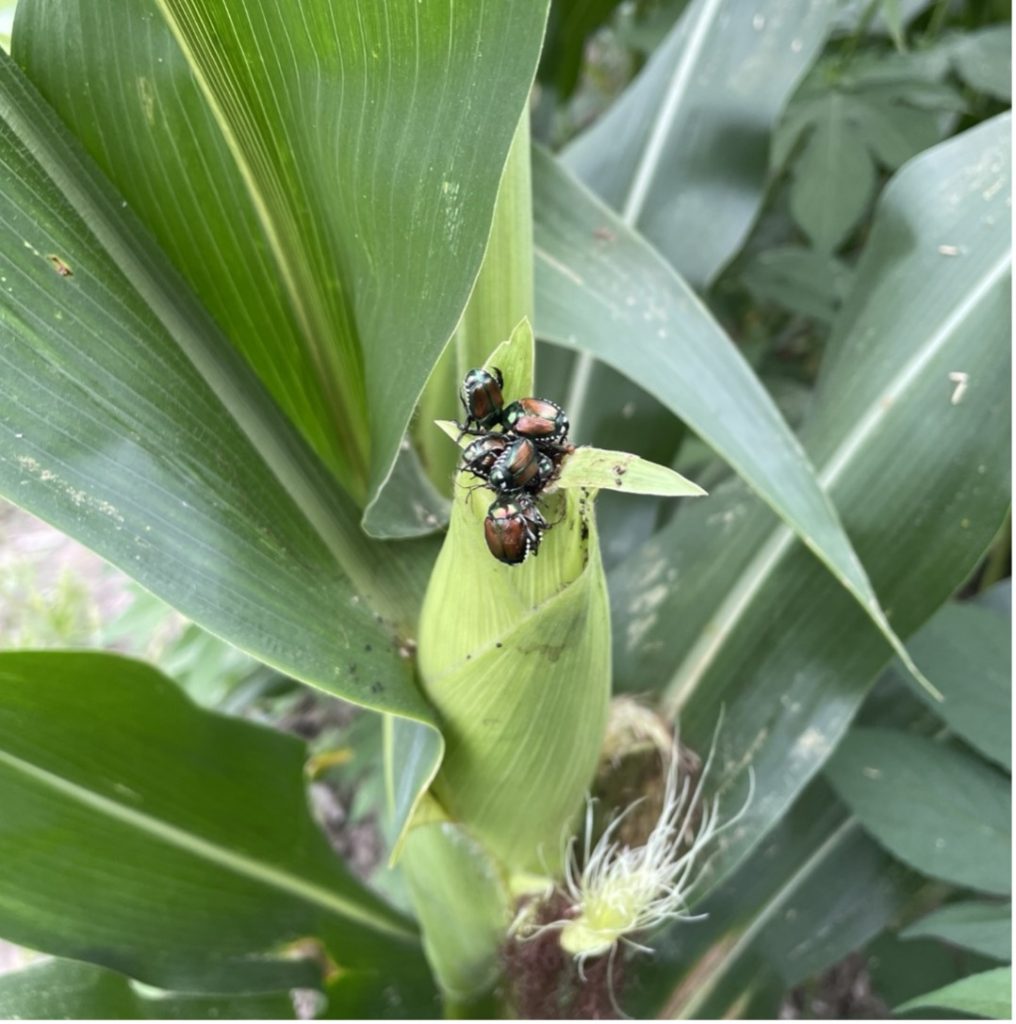
Corn earworm management
Corn earworm (Helicoverpa zea) adults are tan moths ~0.75-1 inch long. Adult moths lay eggs on early-stage green and yellow silks. These eggs hatch and the larvae then crawl down the silk channel and feed on the developing ear and kernels. Since the ears are damaged by larval feeding, management of corn earworm is especially important in hybrid seed corn production fields.
In most cases, pheromone traps can be used to trap male moths and monitor population trends. The DATCP pest survey network moth counts for corn earworm started July 5th and will be updated through mid-September. Based on current counts, Southern counties (like Dane and Dodge counties) have indicated heavy moth pressure between July 5th -11th with those moth numbers dropping significantly the following weeks. Please know moth counts are only loosely related to the number of caterpillars present, which cause the damage.
The number of moths caught is a good indicator of when a treatment may be necessary. If traps capture 5-10 male moths per night and the field is at 10% silking, an insecticide treatment may be warranted. If traps continue to catch 5-10 moths per night, a second insecticide application 7-10 days later should be considered. If the economic threshold is met, reapplication of insecticides for corn earworm is important because the silks continue to grow and the ear zone needs to be protected with a chemical control to stop larval feeding. Always read and follow pesticide labels. If you don’t have any pheromone traps present on your farm, consider checking the weekly updates from the DATCP pest survey network for moth counts.
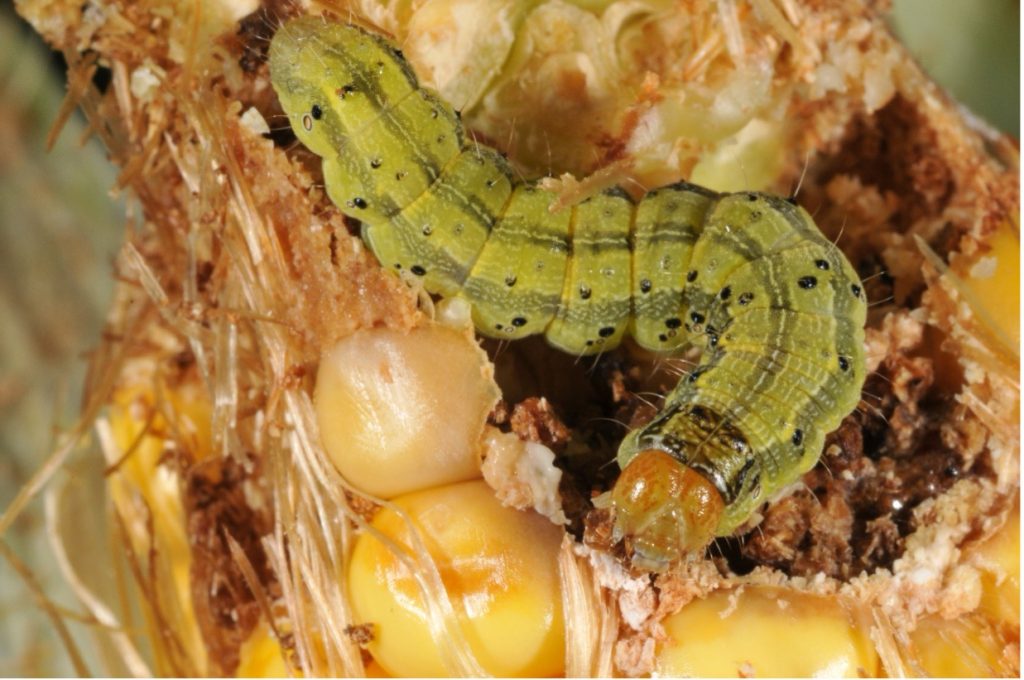

True and Fall armyworm management
Adult true armyworm (Mythimna unipuncta) moths are moderate sized with a wingspan of approximately 1.5 inches. The moths range in color from tan to brown and have a characteristic white spot in the center of their forewing. True armyworm adult moths migrate to WI from southern states and produce two generations of offspring per year. While the adults are not economic pests, the presence of true armyworm moths indicates the pest has reached the area.
Larvae have chewing mouthparts and are the crop damaging life stage of true armyworm, causing significant damage in some areas. These caterpillars have three pairs of claw-like true legs near the head and five pairs of prolegs near the abdomen. A dark band runs the length of the body, sandwiched between pink to orange bands, and a net-like pattern is found on the head. Armyworm larvae will climb into corn whorls or even attack tasseled corn and “rag” the leaves from outside edges towards the midrib, sometimes leaving only mid-ribs on the stalk or eventually eating the stalks to the ground. Leaf feeding above the ear is the most concerning and damaging to the crop.

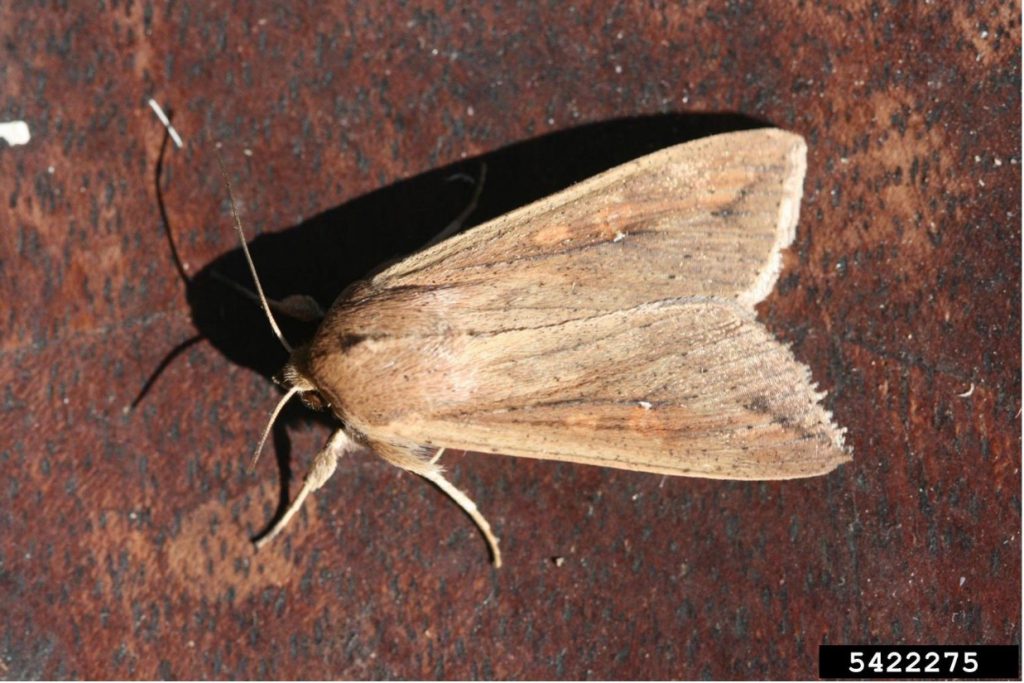
Armyworm moths can be captured in pheromone traps and are monitored across the state as part of the DATCP Pest Survey Program. The exact timing of true armyworm moth arrival in Wisconsin is difficult to predict since it is impacted by weather, but moth movements started in mid-April this year, with peak moth movement between early May and mid-June. According to the DATCP pest survey, moth movement slowed in July and few moths have been trapped this month.
If you find signs of armyworm feeding in corn, check 5 sets of 20 plants at random. Record the number of damaged plants and number of larvae per plant. Treatment of whorl stage corn should be considered if you find two or more armyworms (0.75-1.0 inch or smaller) per plant on 25% of the plants or one per plant on 75% of the plants. In tassel stage corn, feeding above the ear should be minimized. Finding the armyworms when they are still small increases the potential value of your control since treatment is most effective on smaller larvae and plant damage increases as larvae mature.
European corn borer management
European corn borer (Ostrinia nubilalis) moths are small (½ to 5/8 inch long), brownish colored moths with wavy lines on their wings. While adult moths do not cause economic damage, European corn borer larvae can cause significant crop destruction. The larvae, which mature to approximately 1 inch long and have a dark head capsule, can feed on nearly any portion of corn plants, including leaves, stalks, ear shanks, and kernels.
The presence of European corn borer can vary based on location in the state. In Wisconsin, we typically see one generation of European corn borer across the entire state with the southern half of the state seeing an additional generation later in the growing season. At this point in the growing season, we are mostly concerned about the second generation which is attracted to the latest planted corn. The second-generation of European corn borer moths lay eggs over a long period of time and infestations can go unnoticed until ears begin to drop and stalks start to break in the fall.
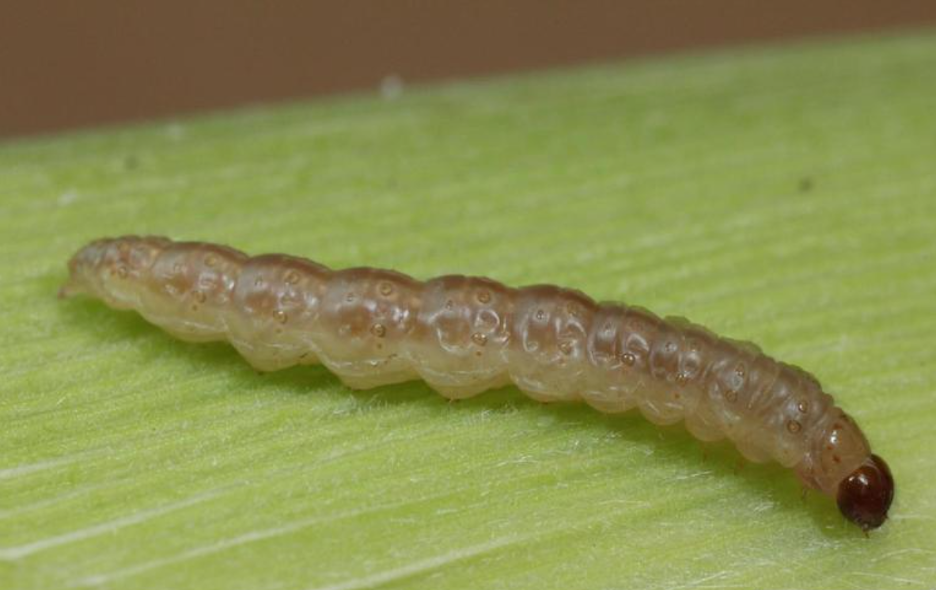
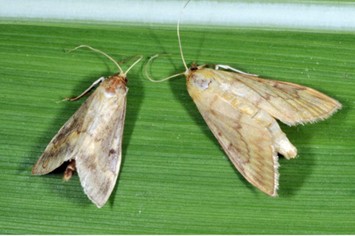
We use degree days to accurately predict European corn borer development. Currently, the southern part of the state has accumulated anywhere from 1450 – 1700 growing degree days, while northern parts of the state are between 950 – 1450 growing degree days. Economic thresholds for the first and second generation are published in A3646.
Bt corn traits express toxin active against European corn borers, but other midwestern states have noticed resistance to the Bt trait forming in European corn borer populations. Though resistance has not been documented in Wisconsin, it could certainly be present, so scouting can be a great way to double check that European corn borer isn’t an issue in your field.
Scouting for the second generation should occur weekly due to the extended egg-laying period. Looking at the undersides of leaves near and above the ear for white egg masses near the leaf midrib. Choose 5-10 plants per area and count the number of egg masses per plant, checking several areas (5-10) throughout the field. Utilize the management worksheet (page 52 of Pest Management in Wisconsin Field Crops) to determine whether treatment will be economically worthwhile. If possible, treat when tiny black dots are apparent on most of the egg masses as these eggs are almost ready to hatch.
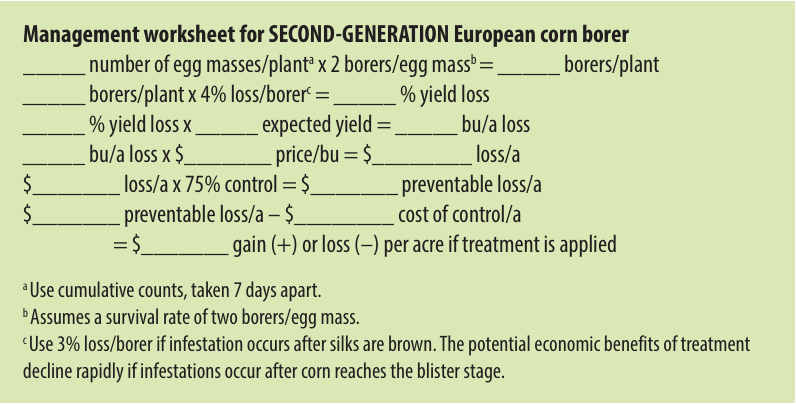
Managing aphids in alfalfa
There are two main types of aphids found in alfalfa in Wisconsin: pea aphids and spotted alfalfa aphids. Pea aphids can be either green or rose colored while spotted alfalfa aphids are yellow and have faint dark spots on their bodies. Aphids cause stunting and yellowing of alfalfa plants by congregating on plant leaves and stems and sucking sap out of the plant. Just like aphids in soybeans, these insect pests can transmit viruses to alfalfa which can cause significant crop issues. In cases where aphids are abundant, treatment should be considered before these plant symptoms occur.
To scout for aphids in alfalfa, the best method is with a sweep net. Walk throughout the field and randomly select areas to sweep. Once an area has been swept, check the net to identify the insects present and the number of each economic pest. If you reach 100 aphids/sweep, a treatment may be warranted.
Grasshopper management
There are many different types of grasshoppers, each with different colorations and identifying characteristics, but much of the damage between species is the same. Most grasshoppers range from 1 ¼ inches long to 2 inches long and range in color from yellow to dark green and they all have large hind legs for jumping. Nymphs and adults can appear very similar except nymphs don’t have fully developed wings. Grasshoppers can impact corn, soybean, and alfalfa, but currently, alfalfa is at the greatest risk for grasshopper feeding. In most cases, grasshoppers are found feeding on new alfalfa growth and their feeding can be identified in alfalfa as irregular-shaped holes on alfalfa leaves.
Scouting for grasshoppers should start in July and continue through September. Grasshoppers are usually not an abundant or economic pest, in some cases, populations may become high enough to warrant treatment. There are two approaches for scouting for grasshoppers. You can use a sweep net and count the number of insects per 20 sweeps or look at the leaf defoliation percentage in areas of the field. In either case the threshold for determining a treatment is 20 grasshoppers per square yard in field margins or 8 grasshoppers per square yard within alfalfa fields. Additionally, when deciding if a treatment is necessary, consider the insect size as smaller sized grasshoppers are more susceptible to insecticides than larger or fully grown grasshoppers. If populations are localized to field edges, a spot or border treatment should be considered.
Lygus plant bug management
The two most common Lygus plant bugs found in Wisconsin are the tarnished plant bug and the alfalfa plant bug. With both plant bugs, both nymphs and adults can be a concern. The tarnished plant bug nymphs can be identified by their greenish yellow color and four dark spots behind their head and a single spot visible on the middle of the abdomen. Adults get to roughly ¼ inch long and have a mottled yellow and brown coloration. The wings angle downward approximately halfway to the tips and each wing has a yellow triangular spot near the bend. Alfalfa plant bug nymphs can be identified by their dark green color and red eyes. Adults reach about 3/8 inch long and have white eyes and dark-tipped cream-colored wings. Both tarnished and alfalfa plant bugs have long, thin antennae and legs. Plant bugs have piercing-sucking mouthparts which extract nutrients and fluids from alfalfa. They also inject toxic saliva which can kill buds, flowers, and seeds. Additionally, egg laying can injure the alfalfa crop as well. In high populations, plant bug damage can manifest as stunted growth or crinkled, puckered leaves.
Scouting for plant bugs is best done with a sweep net. To determine if a treatment is warranted, sample 20 areas of the field, taking 10 sweeps at each sampling area. The thresholds for treatment are based on insect populations and alfalfa growth. On alfalfa less than 3 inches tall, treat if there are three plant bug adults and/or nymphs per sweep. On taller alfalfa, treat when there are five or more adults and/or nymphs per sweep. An insecticide treatment applied within 7-10 days of harvest is unlikely to increase alfalfa yield or quality. For fields within that pre-harvest interval, the best solution may be to harvest the field early.
For more information regarding insecticide options for insect management, refer to A4636 Pest Management in Wisconsin Field Crops 2024.

 ▶ Combine Cleaning: A Simple Step to Reduce Weed Seed Dispersal
▶ Combine Cleaning: A Simple Step to Reduce Weed Seed Dispersal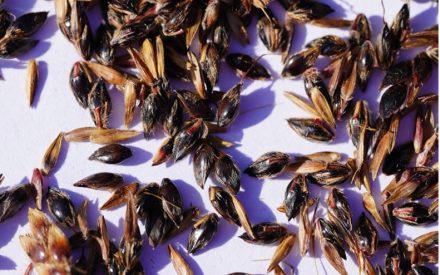 Johnsongrass in Wisconsin
Johnsongrass in Wisconsin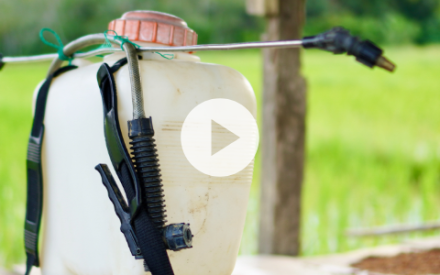 ▶ Backpack Sprayers in Diversified Vegetable Systems
▶ Backpack Sprayers in Diversified Vegetable Systems ▶ AI in Agriculture
▶ AI in Agriculture


